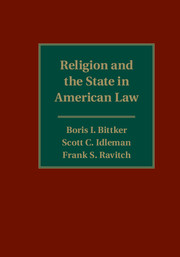Book contents
- Frontmatter
- Dedication
- Contents
- Preface
- 1 History and Introduction
- 2 Church and State in the Nineteenth Century
- 3 Religious Influences and Expressions in Law and Government
- 4 The Establishment Clause
- 5 The Free Exercise Clause
- 6 The Religious Test, Equal Protection, and Free Speech Clauses
- 7 The Definition of Religion
- 8 Church Property Disputes and Church Schisms
- 9 Contracts
- 10 Taxation
- 11 Employment
- 12 Land Use
- 13 Torts
- 14 Criminal Law and Process
- 15 Family Law
- 16 Public Education
- 17 Religious Symbolism on Government Property
- 18 Special Contexts: Prisons and the Military
- Appendix A Federal Constitutional Provisions
- Appendix B State Constitutional Provisions
- Appendix C Selected Federal Statutes 910
- Index
17 - Religious Symbolism on Government Property
Published online by Cambridge University Press: 05 October 2015
- Frontmatter
- Dedication
- Contents
- Preface
- 1 History and Introduction
- 2 Church and State in the Nineteenth Century
- 3 Religious Influences and Expressions in Law and Government
- 4 The Establishment Clause
- 5 The Free Exercise Clause
- 6 The Religious Test, Equal Protection, and Free Speech Clauses
- 7 The Definition of Religion
- 8 Church Property Disputes and Church Schisms
- 9 Contracts
- 10 Taxation
- 11 Employment
- 12 Land Use
- 13 Torts
- 14 Criminal Law and Process
- 15 Family Law
- 16 Public Education
- 17 Religious Symbolism on Government Property
- 18 Special Contexts: Prisons and the Military
- Appendix A Federal Constitutional Provisions
- Appendix B State Constitutional Provisions
- Appendix C Selected Federal Statutes 910
- Index
Summary
Introduction
Courts have repeatedly grappled with the issues raised when government displays religious symbols or religious symbols are displayed by others on government property. Cases involve a variety of religious symbols, for example, Ten Commandments displays, crèches (nativity scenes), Latin crosses,menorahs, and Christmas trees. The analysis in these cases has been the focus of a great deal of scholarly criticism. Most of that criticism is beyond the scope of this chapter. The goal of this chapter is to equip you with knowledge of the leading cases addressing religious symbolism on government property and the legal approaches courts have used, and are currently using, in these cases.
Religious Symbolism Cases
The U.S. Supreme Court has decided a number of cases involving the display of religious objects or symbols by government entities on public property. In Lynch v. Donnelly and in County of Allegheny v. ACLU, the Court addressed the display of nativity scenes – crèches – by government entities. County of Allegheny also involved the display of a large menorah next to an even larger Christmas tree accompanied by a sign saluting liberty.
In Stone v. Graham, the Court addressed a Kentucky statute that required a copy of the Ten Commandments to be placed on a wall in all public school classrooms in the state. More recently, in McCreary County v. ACLU of Kentucky, the Court struck down courthouse displays in two Kentucky counties that included the Ten Commandments, and in Van Orden v. Perry, the Court upheld the display of a Ten Commandments monument on the grounds of the Texas State Capitol. In Pleasant Grove v. Summum, the Court upheld a town's refusal to erect a monument reflecting the Seven Aphorisms of the Summum religion even though the town had a Ten Commandments monument on the same property. The Court addressed the issue as a government speech issue and did not address the possible – some would say probable – Establishment Clause violation in the case.
In Salazar v. Buono, the Court upheld a land transfer that enabled a Latin cross which had served as a war memorial to remain on land that had been public prior to the land transfer. Finally, in Capitol Square Review and Advisory Board v. Pinette, the Court addressed the placement of a large cross on government property that was a public forum.
- Type
- Chapter
- Information
- Religion and the State in American Law , pp. 788 - 808Publisher: Cambridge University PressPrint publication year: 2015



